Wayne Luk
On the Existence and Behaviour of Secondary Attention Sinks
Dec 22, 2025Abstract:Attention sinks are tokens, often the beginning-of-sequence (BOS) token, that receive disproportionately high attention despite limited semantic relevance. In this work, we identify a class of attention sinks, which we term secondary sinks, that differ fundamentally from the sinks studied in prior works, which we term primary sinks. While prior works have identified that tokens other than BOS can sometimes become sinks, they were found to exhibit properties analogous to the BOS token. Specifically, they emerge at the same layer, persist throughout the network and draw a large amount of attention mass. Whereas, we find the existence of secondary sinks that arise primarily in middle layers and can persist for a variable number of layers, and draw a smaller, but still significant, amount of attention mass. Through extensive experiments across 11 model families, we analyze where these secondary sinks appear, their properties, how they are formed, and their impact on the attention mechanism. Specifically, we show that: (1) these sinks are formed by specific middle-layer MLP modules; these MLPs map token representations to vectors that align with the direction of the primary sink of that layer. (2) The $\ell_2$-norm of these vectors determines the sink score of the secondary sink, and also the number of layers it lasts for, thereby leading to different impacts on the attention mechanisms accordingly. (3) The primary sink weakens in middle layers, coinciding with the emergence of secondary sinks. We observe that in larger-scale models, the location and lifetime of the sinks, together referred to as sink levels, appear in a more deterministic and frequent manner. Specifically, we identify three sink levels in QwQ-32B and six levels in Qwen3-14B.
Accelerating 3D Gaussian Splatting with Neural Sorting and Axis-Oriented Rasterization
Jun 08, 2025



Abstract:3D Gaussian Splatting (3DGS) has recently gained significant attention for high-quality and efficient view synthesis, making it widely adopted in fields such as AR/VR, robotics, and autonomous driving. Despite its impressive algorithmic performance, real-time rendering on resource-constrained devices remains a major challenge due to tight power and area budgets. This paper presents an architecture-algorithm co-design to address these inefficiencies. First, we reveal substantial redundancy caused by repeated computation of common terms/expressions during the conventional rasterization. To resolve this, we propose axis-oriented rasterization, which pre-computes and reuses shared terms along both the X and Y axes through a dedicated hardware design, effectively reducing multiply-and-add (MAC) operations by up to 63%. Second, by identifying the resource and performance inefficiency of the sorting process, we introduce a novel neural sorting approach that predicts order-independent blending weights using an efficient neural network, eliminating the need for costly hardware sorters. A dedicated training framework is also proposed to improve its algorithmic stability. Third, to uniformly support rasterization and neural network inference, we design an efficient reconfigurable processing array that maximizes hardware utilization and throughput. Furthermore, we introduce a $\pi$-trajectory tile schedule, inspired by Morton encoding and Hilbert curve, to optimize Gaussian reuse and reduce memory access overhead. Comprehensive experiments demonstrate that the proposed design preserves rendering quality while achieving a speedup of $23.4\sim27.8\times$ and energy savings of $28.8\sim51.4\times$ compared to edge GPUs for real-world scenes. We plan to open-source our design to foster further development in this field.
ASPO: Constraint-Aware Bayesian Optimization for FPGA-based Soft Processors
Jun 07, 2025Abstract:Bayesian Optimization (BO) has shown promise in tuning processor design parameters. However, standard BO does not support constraints involving categorical parameters such as types of branch predictors and division circuits. In addition, optimization time of BO grows with processor complexity, which becomes increasingly significant especially for FPGA-based soft processors. This paper introduces ASPO, an approach that leverages disjunctive form to enable BO to handle constraints involving categorical parameters. Unlike existing methods that directly apply standard BO, the proposed ASPO method, for the first time, customizes the mathematical mechanism of BO to address challenges faced by soft-processor designs on FPGAs. Specifically, ASPO supports categorical parameters using a novel customized BO covariance kernel. It also accelerates the design evaluation procedure by penalizing the BO acquisition function with potential evaluation time and by reusing FPGA synthesis checkpoints from previously evaluated configurations. ASPO targets three soft processors: RocketChip, BOOM, and EL2 VeeR. The approach is evaluated based on seven RISC-V benchmarks. Results show that ASPO can reduce execution time for the ``multiply'' benchmark on the BOOM processor by up to 35\% compared to the default configuration. Furthermore, it reduces design time for the BOOM processor by up to 74\% compared to Boomerang, a state-of-the-art hardware-oriented BO approach.
* Accepted to International Conference on Field-Programmable Logic and Applications (FPL) 2025
A3 : an Analytical Low-Rank Approximation Framework for Attention
May 19, 2025Abstract:Large language models have demonstrated remarkable performance; however, their massive parameter counts make deployment highly expensive. Low-rank approximation offers a promising compression solution, yet existing approaches have two main limitations: (1) They focus on minimizing the output error of individual linear layers, without considering the architectural characteristics of Transformers, and (2) they decompose a large weight matrix into two small low-rank matrices. Consequently, these methods often fall short compared to other compression techniques like pruning and quantization, and introduce runtime overhead such as the extra GEMM kernel launches for decomposed small matrices. To address these limitations, we propose $\tt A^\tt 3$, a post-training low-rank approximation framework. $\tt A^\tt 3$ splits a Transformer layer into three functional components, namely $\tt QK$, $\tt OV$, and $\tt MLP$. For each component, $\tt A^\tt 3$ provides an analytical solution that reduces the hidden dimension size inside each component while minimizing the component's functional loss ($\it i.e.$, error in attention scores, attention outputs, and MLP outputs). This approach directly reduces model sizes, KV cache sizes, and FLOPs without introducing any runtime overheads. In addition, it provides a new narrative in advancing the optimization problem from singular linear layer loss optimization toward improved end-to-end performance. Through extensive experiments, we show that $\tt A^\tt 3$ maintains superior performance compared to SoTAs. For example, under the same reduction budget in computation and memory, our low-rank approximated LLaMA 3.1-70B achieves a perplexity of 4.69 on WikiText-2, outperforming the previous SoTA's 7.87 by 3.18. We also demonstrate the versatility of $\tt A^\tt 3$, including KV cache compression, quantization, and mixed-rank assignments for enhanced performance.
FW-Merging: Scaling Model Merging with Frank-Wolfe Optimization
Mar 16, 2025Abstract:Model merging has emerged as a promising approach for multi-task learning (MTL), offering a data-efficient alternative to conventional fine-tuning. However, with the rapid development of the open-source AI ecosystem and the increasing availability of fine-tuned foundation models, existing model merging methods face two key limitations: (i) They are primarily designed for in-house fine-tuned models, making them less adaptable to diverse model sources with partially unknown model and task information, (ii) They struggle to scale effectively when merging numerous model checkpoints. To address these challenges, we formulate model merging as a constrained optimization problem and introduce a novel approach: Frank-Wolfe Merging (FW-Merging). Inspired by Frank-Wolfe optimization, our approach iteratively selects the most relevant model in the pool to minimize a linear approximation of the objective function and then executes a local merging similar to the Frank-Wolfe update. The objective function is designed to capture the desired behavior of the target-merged model, while the fine-tuned candidate models define the constraint set. More importantly, FW-Merging serves as an orthogonal technique for existing merging methods, seamlessly integrating with them to further enhance accuracy performance. Our experiments show that FW-Merging scales across diverse model sources, remaining stable with 16 irrelevant models and improving by 15.3% with 16 relevant models on 20 CV tasks, while maintaining constant memory overhead, unlike the linear overhead of data-informed merging methods. Compared with the state-of-the-art approaches, FW-Merging surpasses the data-free merging method by 32.8% and outperforms the data-informed Adamerging by 8.39% when merging 20 ViT models.
MetaML-Pro: Cross-Stage Design Flow Automation for Efficient Deep Learning Acceleration
Feb 09, 2025Abstract:This paper presents a unified framework for codifying and automating optimization strategies to efficiently deploy deep neural networks (DNNs) on resource-constrained hardware, such as FPGAs, while maintaining high performance, accuracy, and resource efficiency. Deploying DNNs on such platforms involves addressing the significant challenge of balancing performance, resource usage (e.g., DSPs and LUTs), and inference accuracy, which often requires extensive manual effort and domain expertise. Our novel approach addresses two key issues: cross-stage co-optimization and optimization search. By seamlessly integrating programmatic DNN optimization techniques with high-level synthesis (HLS)-based metaprogramming and leveraging advanced design space exploration (DSE) strategies like Bayesian optimization, the framework automates both top-down and bottom-up design flows, reducing the need for manual intervention and domain expertise. The proposed framework introduces customizable optimization, transformation, and control blocks to enhance DNN accelerator performance and resource efficiency. Experimental results demonstrate up to a 92\% DSP and 89\% LUT usage reduction for select networks, while preserving accuracy, along with a 15.6-fold reduction in optimization time compared to grid search. These results underscore the novelty and potential of the proposed framework for automated, resource-efficient DNN accelerator designs.
Robust Time Series Causal Discovery for Agent-Based Model Validation
Oct 25, 2024Abstract:Agent-Based Model (ABM) validation is crucial as it helps ensuring the reliability of simulations, and causal discovery has become a powerful tool in this context. However, current causal discovery methods often face accuracy and robustness challenges when applied to complex and noisy time series data, which is typical in ABM scenarios. This study addresses these issues by proposing a Robust Cross-Validation (RCV) approach to enhance causal structure learning for ABM validation. We develop RCV-VarLiNGAM and RCV-PCMCI, novel extensions of two prominent causal discovery algorithms. These aim to reduce the impact of noise better and give more reliable causal relation results, even with high-dimensional, time-dependent data. The proposed approach is then integrated into an enhanced ABM validation framework, which is designed to handle diverse data and model structures. The approach is evaluated using synthetic datasets and a complex simulated fMRI dataset. The results demonstrate greater reliability in causal structure identification. The study examines how various characteristics of datasets affect the performance of established causal discovery methods. These characteristics include linearity, noise distribution, stationarity, and causal structure density. This analysis is then extended to the RCV method to see how it compares in these different situations. This examination helps confirm whether the results are consistent with existing literature and also reveals the strengths and weaknesses of the novel approaches. By tackling key methodological challenges, the study aims to enhance ABM validation with a more resilient valuation framework presented. These improvements increase the reliability of model-driven decision making processes in complex systems analysis.
Optimizing VarLiNGAM for Scalable and Efficient Time Series Causal Discovery
Sep 09, 2024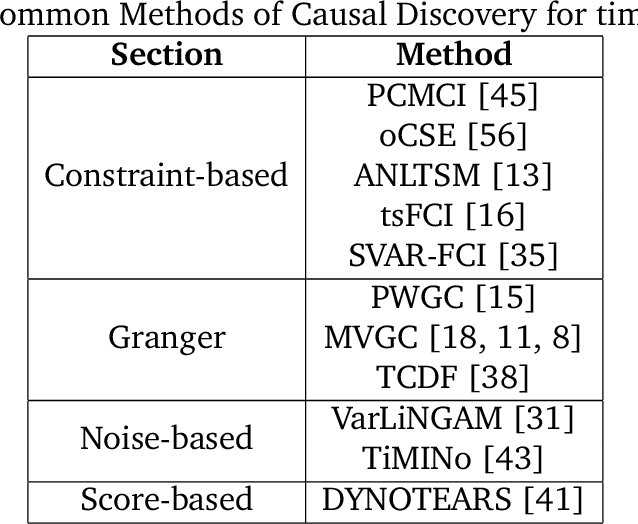
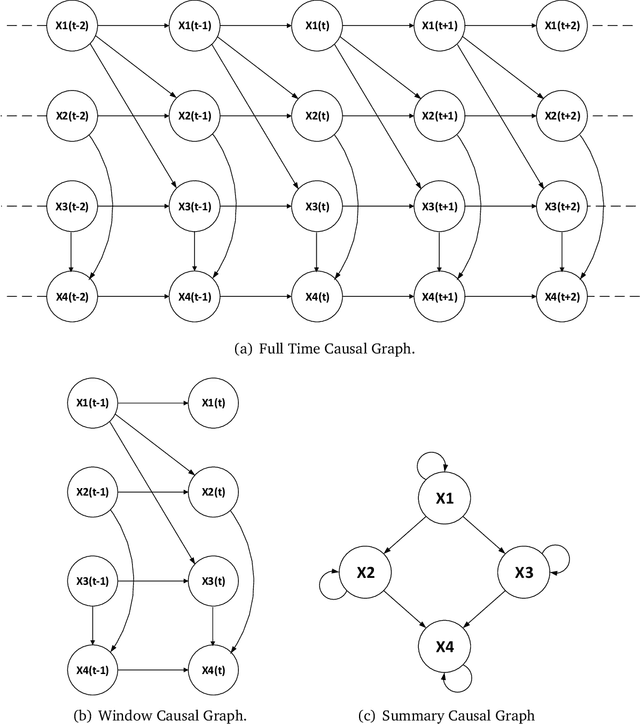
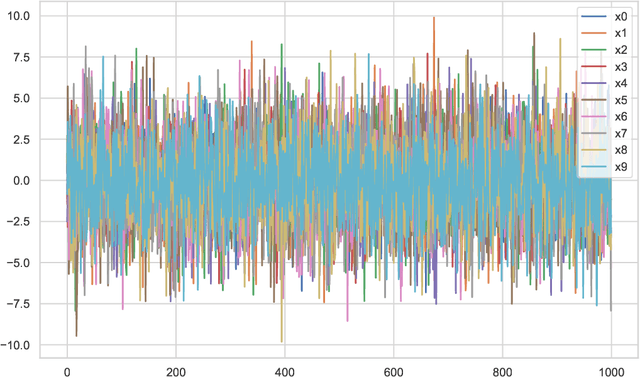
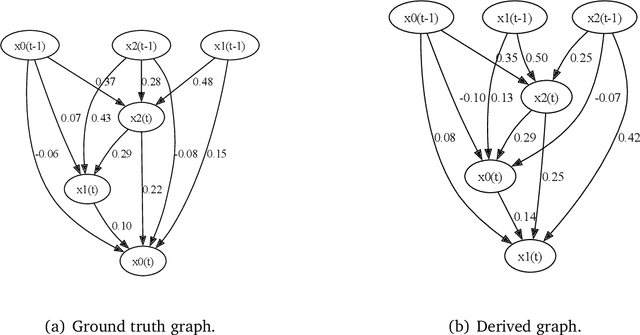
Abstract:Causal discovery is designed to identify causal relationships in data, a task that has become increasingly complex due to the computational demands of traditional methods such as VarLiNGAM, which combines Vector Autoregressive Model with Linear Non-Gaussian Acyclic Model for time series data. This study is dedicated to optimising causal discovery specifically for time series data, which is common in practical applications. Time series causal discovery is particularly challenging due to the need to account for temporal dependencies and potential time lag effects. By designing a specialised dataset generator and reducing the computational complexity of the VarLiNGAM model from \( O(m^3 \cdot n) \) to \( O(m^3 + m^2 \cdot n) \), this study significantly improves the feasibility of processing large datasets. The proposed methods have been validated on advanced computational platforms and tested across simulated, real-world, and large-scale datasets, showcasing enhanced efficiency and performance. The optimised algorithm achieved 7 to 13 times speedup compared with the original algorithm and around 4.5 times speedup compared with the GPU-accelerated version on large-scale datasets with feature sizes between 200 and 400. Our methods aim to push the boundaries of current causal discovery capabilities, making them more robust, scalable, and applicable to real-world scenarios, thus facilitating breakthroughs in various fields such as healthcare and finance.
Accelerating MRI Uncertainty Estimation with Mask-based Bayesian Neural Network
Jul 07, 2024Abstract:Accurate and reliable Magnetic Resonance Imaging (MRI) analysis is particularly important for adaptive radiotherapy, a recent medical advance capable of improving cancer diagnosis and treatment. Recent studies have shown that IVIM-NET, a deep neural network (DNN), can achieve high accuracy in MRI analysis, indicating the potential of deep learning to enhance diagnostic capabilities in healthcare. However, IVIM-NET does not provide calibrated uncertainty information needed for reliable and trustworthy predictions in healthcare. Moreover, the expensive computation and memory demands of IVIM-NET reduce hardware performance, hindering widespread adoption in realistic scenarios. To address these challenges, this paper proposes an algorithm-hardware co-optimization flow for high-performance and reliable MRI analysis. At the algorithm level, a transformation design flow is introduced to convert IVIM-NET to a mask-based Bayesian Neural Network (BayesNN), facilitating reliable and efficient uncertainty estimation. At the hardware level, we propose an FPGA-based accelerator with several hardware optimizations, such as mask-zero skipping and operation reordering. Experimental results demonstrate that our co-design approach can satisfy the uncertainty requirements of MRI analysis, while achieving 7.5 times and 32.5 times speedup on an Xilinx VU13P FPGA compared to GPU and CPU implementations with reduced power consumption.
Exploring FPGA designs for MX and beyond
Jul 01, 2024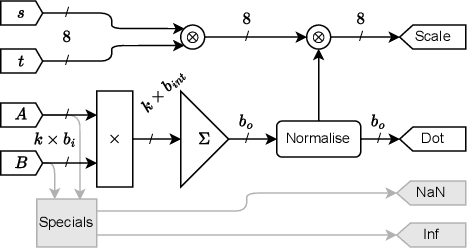

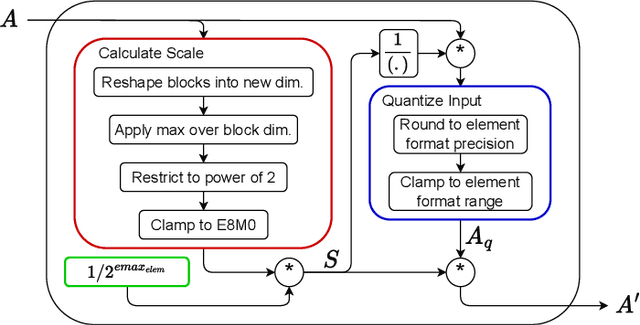
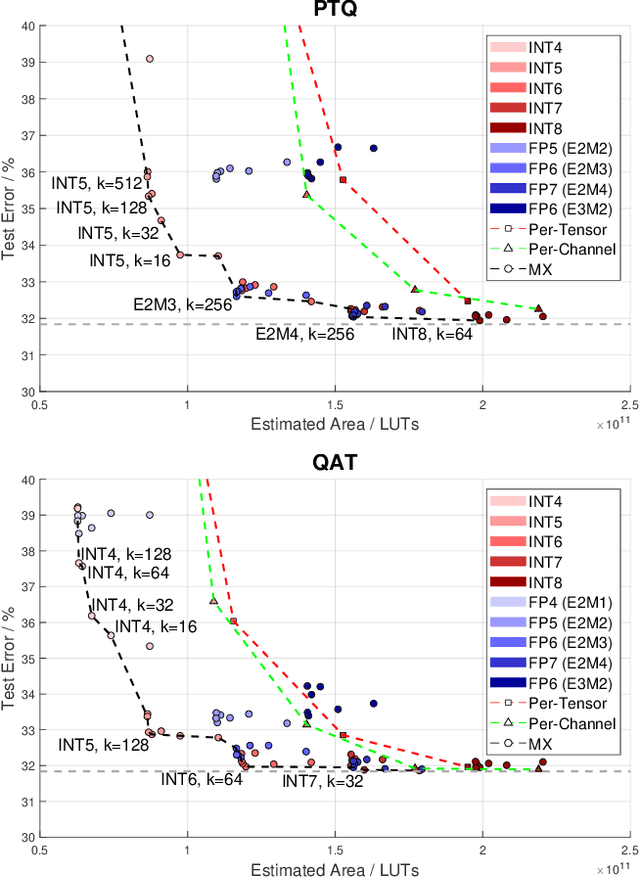
Abstract:A number of companies recently worked together to release the new Open Compute Project MX standard for low-precision computation, aimed at efficient neural network implementation. In this paper, we describe and evaluate the first open-source FPGA implementation of the arithmetic defined in the standard. Our designs fully support all the standard's concrete formats for conversion into and out of MX formats and for the standard-defined arithmetic operations, as well as arbitrary fixed-point and floating-point formats. Certain elements of the standard are left as implementation-defined, and we present the first concrete FPGA-inspired choices for these elements, which we outline in the paper. Our library of optimized hardware components is available open source, and can be used to build larger systems. For this purpose, we also describe and release an open-source Pytorch library for quantization into the new standard, integrated with the Brevitas library so that the community can develop novel neural network designs quantized with MX formats in mind. We demonstrate the usability and efficacy of our libraries via the implementation of example neural networks such as ResNet-18 on the ImageNet ILSVRC12 dataset. Our testing shows that MX is very effective for formats such as INT5 or FP6 which are not natively supported on GPUs. This gives FPGAs an advantage as they have the flexibility to implement a custom datapath and take advantage of the smaller area footprints offered by these formats.
 Add to Chrome
Add to Chrome Add to Firefox
Add to Firefox Add to Edge
Add to Edge